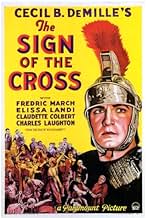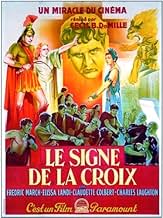AVALIAÇÃO DA IMDb
6,8/10
2,8 mil
SUA AVALIAÇÃO
Nero envia para arena os Cristãos, mas nunca contaria que Marcus intercederia por dois deles que seriam enviados para o sacrifício. Tudo porque se apaixonou por Mercia, filha de um dos que l... Ler tudoNero envia para arena os Cristãos, mas nunca contaria que Marcus intercederia por dois deles que seriam enviados para o sacrifício. Tudo porque se apaixonou por Mercia, filha de um dos que lutariam na arena.Nero envia para arena os Cristãos, mas nunca contaria que Marcus intercederia por dois deles que seriam enviados para o sacrifício. Tudo porque se apaixonou por Mercia, filha de um dos que lutariam na arena.
- Indicado a 1 Oscar
- 2 vitórias e 1 indicação no total
Joyzelle Joyner
- Ancaria
- (as Joyzelle)
Robert Seiter
- Philodemus
- (as Robert Manning)
Enredo
Você sabia?
- CuriosidadesCecil B. DeMille was pressured to drop Ancaria's seductive dance in the orgy scene by Will H. Hays of the Hays Office, but DeMille adamantly refused. Still, censors often cut out gruesome parts of the film, particularly, the cart carrying dead bodies out of the arena, a gorilla dancing around a semi-nude girl, elephants stomping Christians and picking them up with their tusks, crocodiles about to eat a bound girl, etc. These scenes are all in the restored version.
- Erros de gravaçãoIn the Coliseum, we see a woman tied up and is at the mercy of a gorilla. Europeans had no knowledge of gorillas' existence until more than 15 centuries later.
- Versões alternativasRe-released in 1944, with some cuts (sex and sadism scenes) and preceded by a nine minute prologue, set in present time with a WWII theme. This re-release version runs 118 minutes.
- ConexõesEdited into Through the Centuries (1933)
- Trilhas sonorasChristian Hymn No.1
(1932) (uncredited)
Music and Lyrics by Rudolph G. Kopp
Sung a cappella by Christians at the meeting
Reprised by them after their capture and at the arena
Sung a cappella by Elissa Landi and Tommy Conlon
Played and sung offscreen at the end
Avaliação em destaque
Hollywood legend has it that DeMille cast Claudette Colbert as Poppaea by asking her if she'd like to play the "wickedest woman in the world". Who could refuse an offer like that? There are already quite a few excellent (and fun) reviews in this column now, but in view of the DVD release I'd like to add a few things. This lavish picture shows DeMille at his best, worst, most decadent and most unusual. I first saw the expurgated World War II era re-release on TV ages ago, and wasn't much impressed. My father said they'd bowdlerized it a lot, so I was curious to see the 1932 original when it appeared on VHS a few years back. "Astound Me" Diaghilev once famously said to Cocteau; and astounded I was. I was expecting a lot more craziness, but I wasn't expecting to see elephants stepping on men's heads or naked women being eaten by crocodiles. Released in December 1932 it is marginally a pre-code movie, but surely only DeMille could have gotten away with it. This movie has nothing to do with Hollywood of the Thirties; this is Hollywood of the Twenties having one last outrageous fling, with all its sex, drugs, decadence, and all round insanity. The movie plays very much like a silent; perhaps it should have been a silent, thus sparing us its greatest defect, which is some of the worst dialog ever perpetrated. Fredric March as Marcus, the male lead, struggles manfully with awful lines throughout; but it is the visual aspect which dominates one's attention. Consider Colbert's legendary bath in a veritable swimming pool filled with milk (and she's really naked under all that milk). A friend, played by Vivian Tobin with kittenish glee, arrives; they exchange a few verbal barbs worthy of a pair of snarky teenagers, then Poppaea simply says "Take off your clothes. Get in here and tell me all about it." Anyone who thinks the naughty implications of this were inadvertent in innocent old 1932 hasn't spent much time in Hollywood Babylon, to say nothing of Hollywood Rome. Colbert is a delight throughout; her scenes with Fredric March play as high comedy. As he desperately tries to assert his nobility and self control, Colbert effortlessly demolishes his dignity with the perfect lazy grace of a leopardess. And let's not forget Charles Laughton, whose Nero is a masterpiece of omnisexual megalomania. Only Peter Ustinov in the 1951 "Quo Vadis" could better him.
This is on the surface a standard lions vs. Christians epic, but it ain't one to take your Sunday School class to. Under no circumstances should this be viewed by kids, even today. Much of the imagery is equivocal, to put it politely, especially during the big arena show that fills the last half hour. And then there's Marcus' big party, where Joyzelle Joyner performs a dance that is startlingly obscene for 1932.
All of this is ravishingly photographed by cameraman Karl Struss, one of the great artists of monochrome, who makes every shot a work of art. There is one scene in the house occupied by Mercia and her aged guardian, where the old man is seen in a hallway with a gate and small yard beyond; in the yard is an urn. The whole shot is lit by a single brilliant light blasting down on the urn, with bounce boards sending the light gently into the house. This violates all the rules of how to light a scene, but the effect is magical. A quick word should also be put in for Rudolph Kopp, who supplied the music (curiously uncredited); he actually has a go at recreating an authentic ancient Roman sound (no actual ancient Roman music survives).
But the core of the picture is the last part, the ultimate Roman circus. DeMille does something genuinely startling here. First he invites us, a little salaciously, to watch the spectacle, which begins with gladiatorial combat, but proceeds to darker and darker exhibits, many of which are genuinely disturbing (I wasn't kidding about the naked women and the crocodiles; wait until you see the Gaulish Amazon women vs. the Pygmies). As it gets more and more evil, we keep cutting to vivid closeups of the audience that we have been invited to join; some excited, some revolted, some merciless, some bored to distraction, some filled with pity, some sadistic, some almost drooling with voyeurism; they are us, and we are them. DeMille has had the effrontery to show us our own faces as we feast our eyes on all this exquisitely photographed mayhem. It's not easy to watch, and I know of nothing else quite like it prior to Stanley Kubrick.
This is on the surface a standard lions vs. Christians epic, but it ain't one to take your Sunday School class to. Under no circumstances should this be viewed by kids, even today. Much of the imagery is equivocal, to put it politely, especially during the big arena show that fills the last half hour. And then there's Marcus' big party, where Joyzelle Joyner performs a dance that is startlingly obscene for 1932.
All of this is ravishingly photographed by cameraman Karl Struss, one of the great artists of monochrome, who makes every shot a work of art. There is one scene in the house occupied by Mercia and her aged guardian, where the old man is seen in a hallway with a gate and small yard beyond; in the yard is an urn. The whole shot is lit by a single brilliant light blasting down on the urn, with bounce boards sending the light gently into the house. This violates all the rules of how to light a scene, but the effect is magical. A quick word should also be put in for Rudolph Kopp, who supplied the music (curiously uncredited); he actually has a go at recreating an authentic ancient Roman sound (no actual ancient Roman music survives).
But the core of the picture is the last part, the ultimate Roman circus. DeMille does something genuinely startling here. First he invites us, a little salaciously, to watch the spectacle, which begins with gladiatorial combat, but proceeds to darker and darker exhibits, many of which are genuinely disturbing (I wasn't kidding about the naked women and the crocodiles; wait until you see the Gaulish Amazon women vs. the Pygmies). As it gets more and more evil, we keep cutting to vivid closeups of the audience that we have been invited to join; some excited, some revolted, some merciless, some bored to distraction, some filled with pity, some sadistic, some almost drooling with voyeurism; they are us, and we are them. DeMille has had the effrontery to show us our own faces as we feast our eyes on all this exquisitely photographed mayhem. It's not easy to watch, and I know of nothing else quite like it prior to Stanley Kubrick.
- jkogrady-1
- 10 de mai. de 2006
- Link permanente
Principais escolhas
Faça login para avaliar e ver a lista de recomendações personalizadas
- How long is The Sign of the Cross?Fornecido pela Alexa
Detalhes
Bilheteria
- Faturamento bruto nos EUA e Canadá
- US$ 5.971.004
- Tempo de duração2 horas 5 minutos
- Cor
- Proporção
- 1.37 : 1
Contribua para esta página
Sugerir uma alteração ou adicionar conteúdo ausente







































